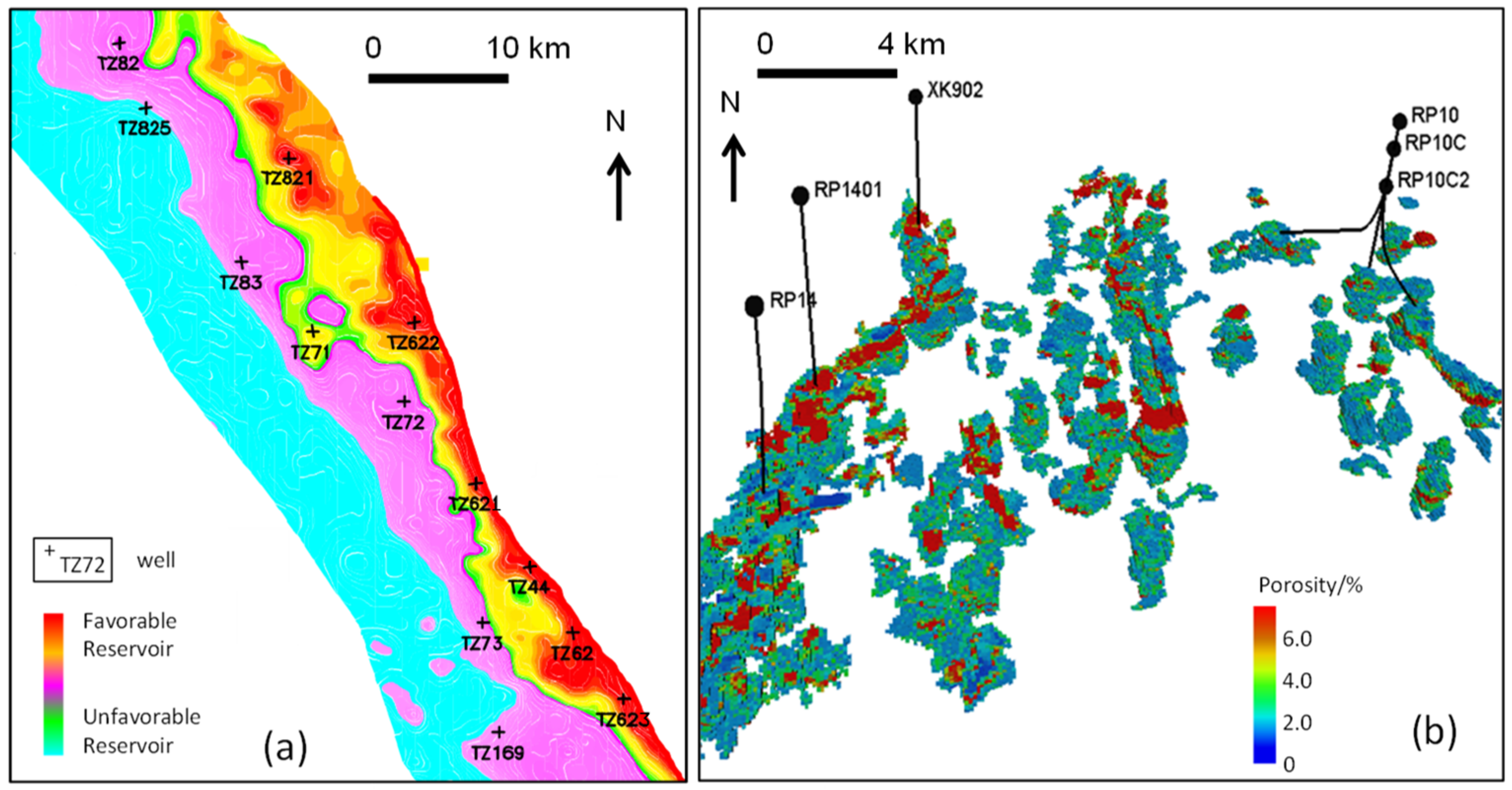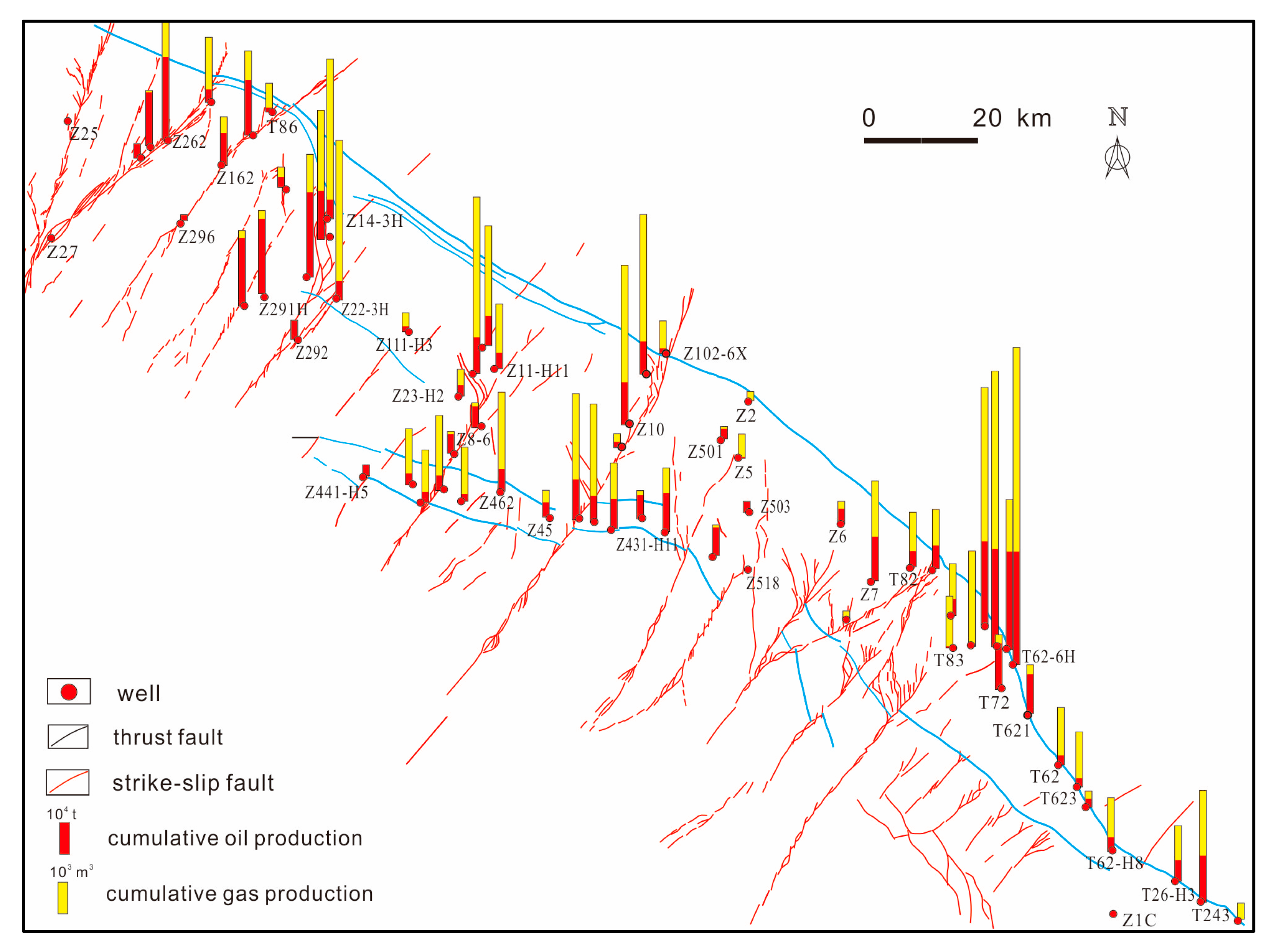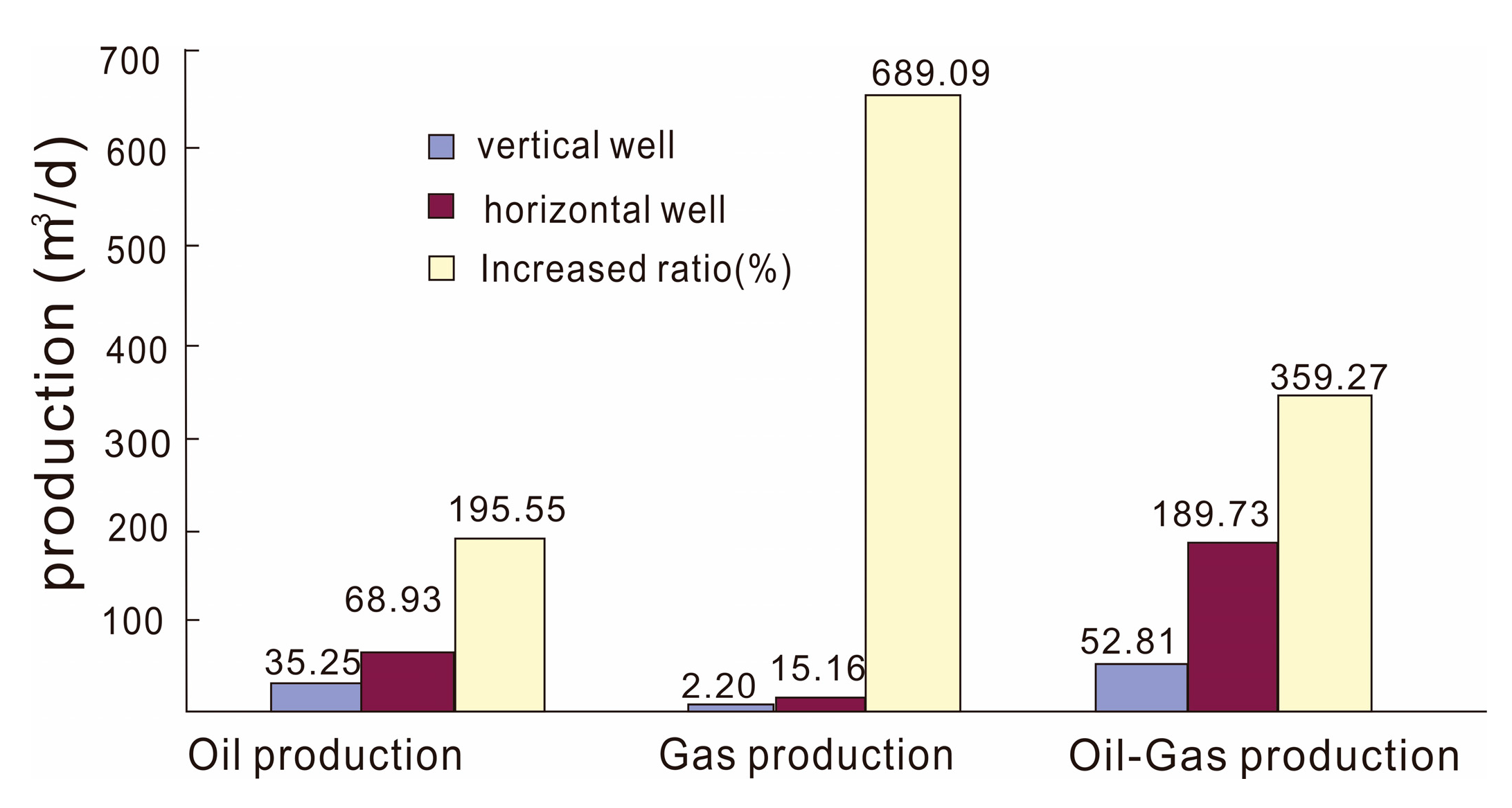An Overview of the Differential Carbonate Reservoir Characteristic and Exploitation Challenge in the Tarim Basin (NW China)
Abstract
:1. Introduction
2. Geological Setting
3. The Carbonate Reservoir, Fluid and Production
3.1. Carbonate Reservoir
3.2. Fluid Distribution
3.3. Oil/Gas Production
4. Discussions
4.1. The Production in Different Reservoirs
4.2. Technology Advance and Challenge for Effective Exploitation
5. Conclusions
- The ancient carbonate reservoirs can be divided into matrix and fractured reservoirs, which correspond to the low and high poro/perm reservoirs, respectively.
- The localized fracture-cave reservoirs are the “sweet spots” for ultra-deep oil/gas field exploitation, but the matrix carbonate reservoirs are too tight to obtain economic production by conventional/unconventional development methods.
- It needs further advances in horizontal drilling and large multiple fracturing techniques for the matrix reservoir exploitation, and seismic quantitative description and horizontal drilling techniques across the fault zone for the fractured reservoir production.
Author Contributions
Funding
Institutional Review Board Statement
Informed Consent Statement
Data Availability Statement
Acknowledgments
Conflicts of Interest
References
- Garland, J.; Neilson, J.; Laubach, S.E.; Whidden, K.J. Advances in carbonate exploration and reservoir analysis. Geol. Soc. Lond. Spec. Publ. 2012, 370, 1–15. [Google Scholar] [CrossRef] [Green Version]
- Bai, G.P.; Cao, B.F. Characteristics and distribution patterns of deep petroleum accumulations in the world. Oil Gas Geol. 2014, 35, 19–25, (In Chinese with English Abstract). [Google Scholar]
- Zhang, G.Y.; Ma, F.; Liang, Y.B.; Zhao, Z.; Qin, Y.Q.; Liu, X.B.; Zhang, K.B.; Ke, W.L. Domain and theory-technology progress of global deep oil & gas exploration. Acta Pet. Sin. 2015, 36, 1156–1166, (In Chinese with English Abstract). [Google Scholar]
- Li, J.Z.; Tao, X.W.; Bai, B.; Huang, S.P.; Jiang, Q.C.; Zhao, Z.Y.; Chen, Y.Y.; Ma, D.B.; Zhang, L.P.; Li, N.X.; et al. Geological conditions, reservoir evolution and favorable exploration directions of marine ultra-deep oil and gas in China. Pet. Explor. Dev. 2021, 48, 60–79. [Google Scholar] [CrossRef]
- Sun, L.D.; Zou, C.N.; Zhu, R.K.; Zhang, Y.H.; Zhang, S.C.; Zhang, B.M.; Zhu, G.Y.; Gao, Z.Y. Formation, distribution and potential of deep hydrocarbon resources in China. Pet. Explor. Dev. 2013, 40, 687–695. [Google Scholar] [CrossRef]
- Bruna, P.O.; Guglielmi, Y.; Lamarche, J.; Floquet, M.; Fournier, F.; Sizun, J.P.; Gallois, A.; Marié, L.; Bertrand, C.; Hollender, F. Porosity gain and loss in unconventional reservoirs: Example of rock typing in Lower Cretaceous hemipelagic limestones, SE France (Provence). Mar. Pet. Geol. 2013, 48, 186–205. [Google Scholar] [CrossRef]
- Rashid, F.; Glover, P.W.J.; Lorinczi, P.; Collier, R.; Lawrence, J. Porosity and permeability of tight carbonate reservoir rocks in the north of Iraq. J. Pet. Sci. Eng. 2015, 133, 147–161. [Google Scholar] [CrossRef] [Green Version]
- Yang, H.J.; Wu, G.H.; Nicola, S.; Sun, C.H.; Qing, H.R.; Han, J.F.; Zhang, J.W. Characterization of reservoirs, fluids, and productions from the Ordovician carbonate condensate field in the Tarim Basin, northwestern China. AAPG Bull. 2020, 104, 1567–1592. [Google Scholar] [CrossRef]
- Abouelresh, M.O.; Mahmoud, M.; Radwan, A.E.; Dodd, T.J.H.; Kong, L.Y.; Hassan, H.F. Characterization and classification of the microporosity in the unconventional carbonate reservoirs: A case study from Hanifa Formation, Jafurah Basin, Saudi Arabia. Mar. Pet. Geol. 2022, 145, 105921. [Google Scholar] [CrossRef]
- Wang, Q.H.; Zhang, Y.T.; Xie, Z.; Zhao, Y.W.; Zhang, C.; Sun, C.; Wu, G.H. The advance and challenge of seismic technique on the ultra-deep carbonate reservoir exploitation in the Tarim Basin, Western China. Energies 2022, 15, 7653. [Google Scholar] [CrossRef]
- He, X.; Guo, G.; Tang, Q.; Wu, G.; Xu, W.; Ma, B.; Huang, T.; Tian, W. The advances and challenges of the Ediacaran fractured reservoir development in the central Sichuan Basin, China. Energies 2022, 15, 8137. [Google Scholar] [CrossRef]
- Bouchaala, F.; Ali, M.Y.; Matsushima, J.; Bouzidi, Y.; Takougang, E.M.T.; Mohamed, A.A.; Sultan, A. Azimuthal investigation of compressional seismic-wave attenuation in a fractured reservoir. Geophysics 2019, 84, 437–446. [Google Scholar] [CrossRef]
- Wu, G.H.; Zhao, K.Z.; Qu, H.Z.; Nicola, S.; Zhang, Y.T.; Han, J.F.; Xu, Y.F. Permeability distribution and scaling in multi-stages carbonate damage zones: Insight from strike-slip fault zones in the Tarim Basin, NW China. Mar. Pet. Geol. 2020, 114, 104208. [Google Scholar] [CrossRef]
- Benmadi, M.; Sayantan, G.; Roger, S.; Kurt, M.; Mashhad, F. Practical aspects of upscaling geocellular geological models for reservoir fluid flow simulations: A case study in integrating geology, geophysics, and petroleum engineering multiscale data from the Hunton Group. Energies 2020, 13, 1604. [Google Scholar]
- Babasafari, A.A.; Chinelatto, G.F.; Vidal, A.C. Fault and fracture study by incorporating borehole image logs and supervised neural network applied to the 3D seismic attributes: A case study of pre-salt carbonate reservoir, Santos Basin, Brazil. Pet. Sci. Technol. 2022, 40, 1492–1511. [Google Scholar] [CrossRef]
- Du, J. Oil and Gas Exploration of Cambrian-Ordovician Carbonate in Tarim Basin; Petroleum Industry Press: Beijing, China, 2010. (In Chinese) [Google Scholar]
- Wu, G.H.; Pang, X.Q.; Li, Q.M.; Yang, H.J. Structural Characteristics in Intracratonic Carbonate Rocks and Its Implication for Oil/Gas Accumulation: A Case Study in the Tarim Basin, China; Chinese Science Press: Beijing, China, 2016. (In Chinese) [Google Scholar]
- Tian, J.; Wang, Q.H.; Yang, H.J.; Li, Y. Petroleum Exploration History and Enlightenment in Tarim Basin. Xinjiang Pet. Geol. 2021, 42, 272–282, (In Chinese with English Abstract). [Google Scholar]
- Zhang, H.; Cai, Z.X.; Qi, L.X.; Yun, L. Diagenesis and origin of porosity formation of Upper Ordovician carbonate reservoir in northwestern Tazhong condensate field. J. Nat. Gas Sci. Eng. 2017, 38, 139–158. [Google Scholar] [CrossRef]
- Wang, X.; Zhang, J.; Li, J.; Hu, S.; Kong, Q. Conventional logging identification of fracture-vug complex types data based on crossplots-decision tree:A case study from the Ordovician in Tahe oilfield, Tarim Basin. Oil Gas Geol. 2017, 38, 805–812, (In Chinese with English Abstract). [Google Scholar]
- Wang, R.J.; Yang, J.P.; Chang, L.J.; Zhang, Y.T.; Sun, C.; Wu, G.H.; Bai, B.C. 3D modeling of fracture-cave reservoir from an ultra−depth strike−slip fault−controlled carbonate oilfield in Northwestern China. Energies 2022, 15, 6415. [Google Scholar] [CrossRef]
- Wang, Z.; Sun, C.; Yang, H.; Zhou, C.; Zhang, Z. Formation pattern of upper ordovician reef-bank complex along the Tazhong Slopebreak I, tarim block, NW China. Acta Geol. Sin. 2010, 84, 546–552. [Google Scholar]
- Liu, J.Q.; Li, Z.; Huang, J.C.; Yang, L. Distinct sedimentary environments and their influences on carbonate reservoir evolution of the Lianglitag Formation in the Tarim Basin, Northwest China. Sci. China-Earth Sci. 2012, 55, 1641–1655. [Google Scholar] [CrossRef]
- Zhang, Y.F.; Tan, F.; Sun, Y.B.; Pan, W.Q.; Wang, Z.Y.; Yang, H.Q.; Zhao, J.X. Differences between reservoirs in the intra-platform and platform margin reef-shoal complexes of the Upper Ordovician Lianglitag Formation in the Tazhong oil field, NW China, and corresponding exploration strategies. Mar. Pet. Geol. 2018, 98, 66–78. [Google Scholar] [CrossRef] [Green Version]
- Wu, G.H.; Xie, E.; Zhang, Y.F.; Qing, H.R.; Luo, X.S.; Sun, C. Structural diagenesis in carbonate fault damage zones in the northern Tarim Basin, NW China. Minerals 2019, 9, 360. [Google Scholar] [CrossRef] [Green Version]
- Wu, G.H.; Yang, H.J.; He, S.; Cao, S.J.; Liu, X.; Jing, B. Effects of structural segmentation and faulting on carbonate reservoir properties: A case study from the Central Uplift of the Tarim Basin, China. Mar. Pet. Geol. 2016, 71, 183–197. [Google Scholar] [CrossRef]
- Zhao, Y.; Wu, G.; Zhang, Y.; Scarselli, N.; Yan, W.; Sun, C.; Han, J. The strike-slip fault effects on tight Ordovician reef-shoal reservoirs in the central Tarim Basin. Energies 2023, 16, 2575. [Google Scholar] [CrossRef]
- Chen, Q.; Zhao, Y.; Li, G.; Chu, C.; Wang, B. Features and controlling factors of epigenic karstification of the ordovician carbonates in Akekule arch, Tarim basin. J. Earth Sci. 2012, 23, 506–515. [Google Scholar] [CrossRef]
- Zhang, X.F.; Li, M.; Chen, Z.Y.; Jiang, H.; Tang, J.W.; Liu, B.; Gao, J.X. Characteristics and karstification of the Ordovician carbonate reservoir, Halahatang area, northern Tarim Basin. Acta Petrol. Sin. 2012, 28, 815–826. [Google Scholar]
- Yu, J.B.; Li, Z.; Yang, L. Fault system impact on paleokarst distribution in the Ordovician Yingshan Formation in the central Tarim basin, northwest China. Mar. Pet. Geol. 2016, 71, 105–118. [Google Scholar] [CrossRef]
- Wu, G.H.; Ma, B.S.; Han, J.; Guan, B.Z.; Chen, X.; Yang, P.; Xie, Z. Origin and growth mechanisms of strike-slip faults in the central Tarim cratonic basin, NW China. Pet. Explor. Dev. 2021, 48, 510–520. [Google Scholar] [CrossRef]
- Wu, G.H.; Gao, L.H.; Zhang, Y.T.; Ning, C.Z.; Xie, E. Fracture attributes in reservoir-scale carbonate fault damage zones and implications for damage zone width and growth in the deep subsurface. J. Struct. Geol. 2019, 118, 181–193. [Google Scholar] [CrossRef]
- Lu, X.B.; Wang, Y.; Tian, F.; Li, X.H.; Yang, D.B.; Li, T.; Lv, Y.P.; He, X.M. New insights into the carbonate karstic fault system and reservoir formation in the Southern Tahe area of the Tarim Basin. Mar. Pet. Geol. 2017, 86, 587–605. [Google Scholar] [CrossRef]
- Shanley, K.W.; Cluff, R.M.; Robinson, J.W. Factors controlling prolific gas production from low-permeability sandstone reservoirs. AAPG Bull. 2004, 88, 1083–1121. [Google Scholar] [CrossRef] [Green Version]
- Hakami, A.; Al-Mubarak, A.; Al-Ramadan, K.; Kurison, C.; Leyva, I. Characterization of carbonate mudrocks of the Jurassic Tuwaiq Mountain Formation, Jafurah basin, Saudi Arabia: Implications for unconventional reservoir potential evaluation. J. Nat. Gas Sci. Eng. 2016, 33, 1149–1168. [Google Scholar] [CrossRef]
- Zou, C.N.; Zhai, G.M.; Zhang, G.Y.; Wang, H.J.; Zhang, G.S.; Li, J.Z.; Wang, Z.M.; Wen, Z.X.; Ma, F.; Liang, Y.B.; et al. Formation, distribution, potential and prediction of global conventional and unconventional hydrocarbon resources. Pet. Explor. Dev. 2015, 42, 13–25. [Google Scholar] [CrossRef]
- Adam, L.; Batzle, M.; Lewallen, K.T.; van Wijk, K. Seismic wave attenuation in carbonates. J. Geophys. Res. Sol. Earth 2009, 114, B06208–B06221. [Google Scholar] [CrossRef] [Green Version]
- Bouchaala, F.; Ali, M.Y.; Matsushima, J.; Bouzidi, Y.; Takougang, E.T.; Mohamed, A.A.; Sultan, A.A. Scattering and intrinsic attenuation as a potential tool for studying of a fractured reservoir. J. Pet. Sci. Eng. 2019, 174, 533–543. [Google Scholar] [CrossRef]









Disclaimer/Publisher’s Note: The statements, opinions and data contained in all publications are solely those of the individual author(s) and contributor(s) and not of MDPI and/or the editor(s). MDPI and/or the editor(s) disclaim responsibility for any injury to people or property resulting from any ideas, methods, instructions or products referred to in the content. |
© 2023 by the authors. Licensee MDPI, Basel, Switzerland. This article is an open access article distributed under the terms and conditions of the Creative Commons Attribution (CC BY) license (https://creativecommons.org/licenses/by/4.0/).
Share and Cite
Chen, L.; Jiang, Z.; Sun, C.; Ma, B.; Su, Z.; Wan, X.; Han, J.; Wu, G. An Overview of the Differential Carbonate Reservoir Characteristic and Exploitation Challenge in the Tarim Basin (NW China). Energies 2023, 16, 5586. https://doi.org/10.3390/en16155586
Chen L, Jiang Z, Sun C, Ma B, Su Z, Wan X, Han J, Wu G. An Overview of the Differential Carbonate Reservoir Characteristic and Exploitation Challenge in the Tarim Basin (NW China). Energies. 2023; 16(15):5586. https://doi.org/10.3390/en16155586
Chicago/Turabian StyleChen, Lixin, Zhenxue Jiang, Chong Sun, Bingshan Ma, Zhou Su, Xiaoguo Wan, Jianfa Han, and Guanghui Wu. 2023. "An Overview of the Differential Carbonate Reservoir Characteristic and Exploitation Challenge in the Tarim Basin (NW China)" Energies 16, no. 15: 5586. https://doi.org/10.3390/en16155586




